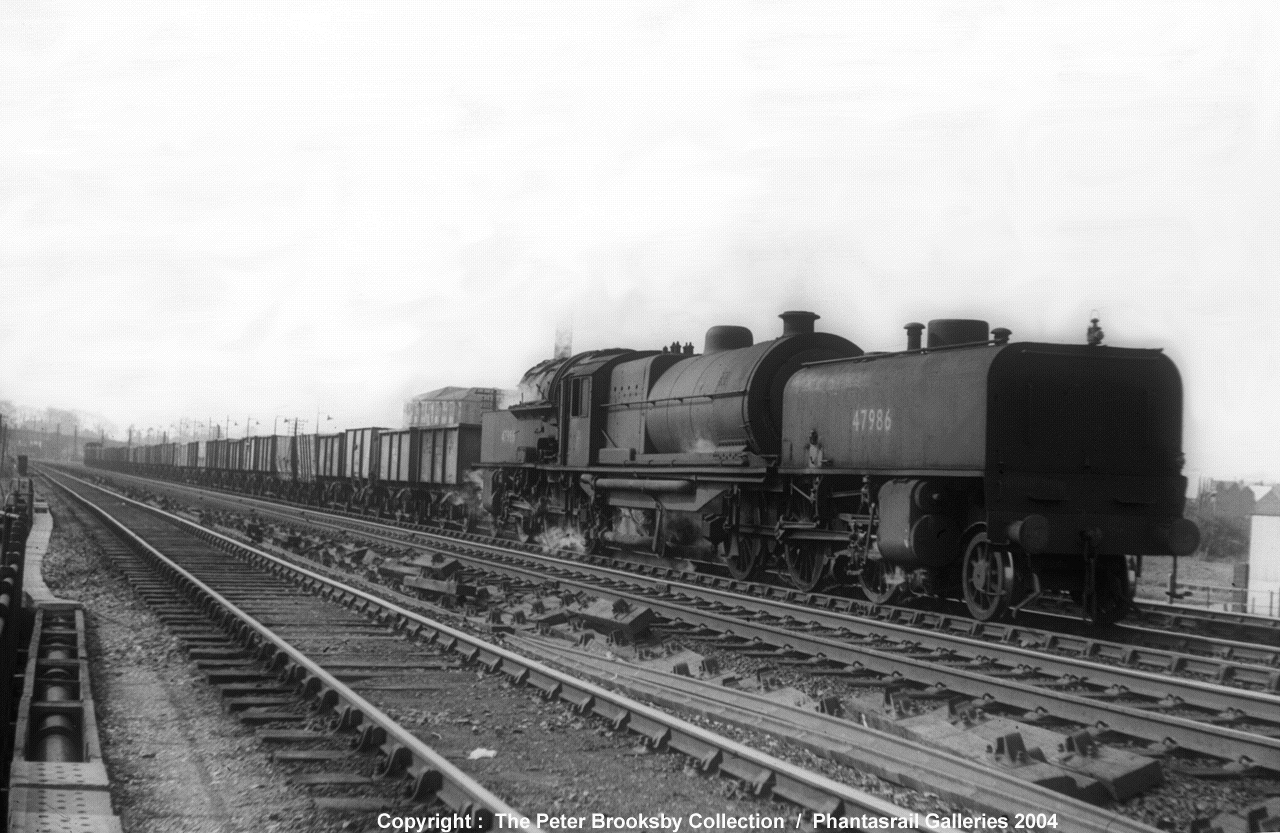The powerful Garratt style locomotive, basically two engines in one (not too disimlar to the Farilie arrangement) has been a valuable addition to many locomotive fleets of several countries. Many African nations (for example Rhodesia and South Africa) depended on the use of these designs well into the 1980s and '90s. Their ability to work well on tightly curving tracks and being able to haul very heavy trains over long distances and changing gradients has allowed the type to spread all over the globe, from Tanzania to Tasmania. Beyer Peacock (the company that never built an ugly locomotive) was the first to build a Garratt locomotive: the K1 for the North-East Dundas Tramway in Tasmania. This locomotive happily survives today in full working order on the Welsh Higland Railways.
Surprisngly, britain itself had used only two main-line standard gauge garratts: the LMS' 33 Beyer-Garratts, and the LNER's U1, designed by Sir Nigel Gresley and the most powerful steam locomotive ever to run in Britain.

Top: the LMS Beyer Garratt in service and right: the LNER's powerful U1 in its official works portrait.
Both of these designs were plagued by two facts: one, that they were difficult to fire due to the lack of automatic coal pushers, and also, Britain's railways really were unsuitable grounds for them. Garratts are best deployed in difficult terrain or with exceptionally heavy loads, which makes them economically viable. There were certainly heavy loads, but the problame is they didn't materialse often enough- and to make matters worse, sidings and crossing loops for the extended trains were far too small. This is similar to what had occured with Nigel Gresley's excellent P1 design: it worked superbly, but the huge loads it was supposed to pull were rare.
The U1 was actually designed to bank coal trains over the steep Worsborough Bank on the famous Woodhead Route in its pre-electric days (reasons for it being known as the 'Wath Banker'). In its life it was converted to an oil burner with limited sucess, and was tried out on the Lickey Incline as a replacement for the legendary 'Big Bertha', however it was mostly unsuccessful. It was withdrawn and scrapped in 1955. Crews disliked the locomotive because of the massive amount of coal shoveling involved to keep it running, coupled with hellish breathing conditions created by the smoke it relased when banking in the Silkstone Tunnels. The garratt's crews were notorious for failing it for the slightest reason if it meant they wouldn't have to use the locomotive that day. Among other problems, it also suffered from excessive boiler corrosion due to the very soft water it was fueled with.
As for the 33 beyer-Garratts on the LMS, they suffered from a critical defect: they were designed according to the Midland's 'Small engines' policy- and had only standard axle boxes which suffered from critical overheating. Their coal consumption was terrible and like the LNER's U1 they were maintenance nightmares.
One good point about the LMS design was its revolving coal bunker on the later engines which made the fireman's lot much easier. However, there was still no automatic coal pusher.
So, the verdict for the two sole garratt designs to operationally serve in Britain? Both were flawed, and were in some ways uneccesary- the design was meant for curved and diffcult terrain with plenty of siding room for accomodating long trains- not what they operated on. Also, despite their power, the type should have been selected for use only with the heaviest and longest trains to make them economically viable. As it was, these trains were realitely few in those days (a problem shown, as mentioned, with the otherwise excellent P1 mikado of the LNER). However, for banking purposes, the design was also flawed. Such needs could have been met by a more conventional locomotive: for example in the style of the classic 0-10-0 'Big Bertha' wich was perfect for use on the sharp Lickey Incline.
Certainly, though, both designs did at least give the two operating companies some serious pulling might. the U1, as mentioned, gave its designer yet another record to add to his book: the most powerful British steam engine ever. The LMS design might well have been better had it not been for the restrictive loading gauge and the faulty axle boxes.
Despite the Garratt design's failure to become entrenched in British Steam annals, it acheived great success on another continent where there was the space, heavy train loads and terrain that meant the type could achieve success. In the next part, I will talk about, of course, the Australian Garratts and their excellent, far more lasting service.
Saturday, March 1, 2008
The Mighty Garratts Part One: British Edition
Posted by Klink at Saturday, March 01, 2008
Subscribe to:
Post Comments (Atom)




4 comments:
The Midland Garratts could have been successful had Henry Fowler not succumbed as you rightly point out to the small axle box bearing policy of the Midland. I understand Beyer Peacock tried to argue him out of that. The only other Garratts in the UK at the time was a 0-4-0 + 0-4-0 use by a colliery in the Midlands. Now we have the original 2 foot gauge prototype operating on the Welsh Highland. The WHR in Wales also uses two or three imported from South Africa.
The most successful banker on the Lickey Incline was the ubiquitous Riddles 2-10-0 9F and they also also up to four pannier tanks or Jinties! What a sight!
Have a look at www.lickeyincline.co.uk and the associated blog at lickeyincline.blogspot.com
Bye for now
Thanks Holman for your comments, I had a look at your site also- The Lickey Incline, particularly that wonderful one-off 'Big Bertha' has been most interesting for me for a long time.
You state Garratts as being not very dissimilar to the Fairlie arrangement. Well I strongly disagree to that. Just about the only similarty both types have is the fact that they both have two sets of driving wheels facing "outward". For the rest the differences are huge. The "trucks" pivoted right on the aother end: the Fairlie between the cylinders and the Garratt almost at the rear (most inward) end. The original Fairlie had a double boiler which had to be rather narrow because of its relative high pitch. The Garratt in contrast had a single boiler which was pitch relatively low, enabling a diameter to the breadth of the loading gauge. The superior design principle of the Garratt allowed it to become the second most wide spread articulated design (after the mallet) with sizes ranging to the the largest locomotives ever built, whereas the limitations of the Fairlie design restricted it to rather secondary aplications.
Actually, the largest locomotives ever built were the massive American articulated and some truly monstrous Russian designs that were ridiculously impractible. You are correct in pointing out that the Garratts are very different to the Fairlies, I merely said they were not dissimilar- the principles remain the same: two engines in one with articulation designed to give power and stabilty on tight curves. Also, Not all the Garratts were driven with the driving wheels out: the very first series built for Tasmania, the K Class, had their pistons on the opposite sides as well as compounding.
The Fairlie type was never given much of a chance on mainline operation in Great Britain, apart from some prototypes such as a single Fairlie built for the Swindon, Marlborough and Andover Railway (the first engine in the UK with Walscharts' gear). However, the Garratt hardly did well in Britain either. The LNER one was too powerful for its role, a P1 probably could have done its job; and the Midland Garratts were ruined by the LMS small engine poilicy.
The reason for the Garratts success was undoubtedly due to its relative conventionality, compared to the more difficult Fairlies. It must be noted that America never pursued the type, here in Australia it was used very successfully on the heaviest trains (the famous W.44 Zinc Concentrate train in New South Wales had double headed AD60 Garratts). Also, the Fairlie type never had a company champion their design like Beyer-Peacock did with the Garratt.
However, I respect your opinion, since we both have our correct points, there is no point in arguing since I doubt we'll agree. Besides, this blog was built for discussion! Thanks for reading anyway.
Post a Comment